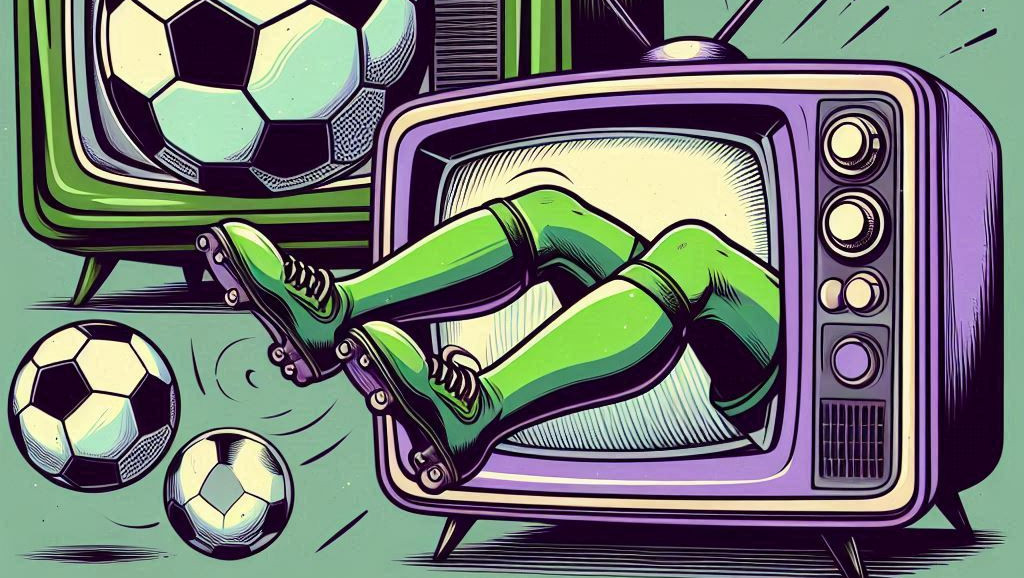Can Sports Streaming Knock Out Linear TV?
by on 28th Aug 2024 in News

Linear television has been on the decline for quite some time now. Despite viewers and advertisers alike gradually turning more and more of their attention and ad spend towards connected TV (CTV), sports was the bastion which had managed to hold on the tightest. Lately, however, we’ve been witnessing streaming pry the sporting scene from the quaking hands of traditional broadcasting. What’s coming next for sports on TV? As we delve into the topic, the only certainty is that there is more convergence between different forms of TV than ever before.
A record-breaking year
It has been a good year so far for both linear and streaming. People all over the globe tuning into this year’s summer of sports has caused TV viewership figures to surge. The England vs Spain final of the Euros was watched by a peak audience of 24.2 million across ITV and BBC – an impressive figure despite falling short of the viewership achieved during the 2020 Euros.
The number of those who purchased streaming subscriptions to watch the coverage rose dramatically in Europe: 215 million viewers tuned into Warner Bros Discovery’s coverage within the region. The broadcasting giant’s number of paid streaming subscribers rose 77% compared to the Tokyo 2020 games. As a result of the deal it struck in 2015 with the International Olympic Committee, it gained pan-European rights (and most UK TV rights) to the games from 2018 to 2024 – consequently, the BBC lost its right to freely stream all the games footage in the UK. The BBC was still able to stream limited coverage, however, thanks to UK law which mandates that the event’s coverage must be accessible to the public on free-to-air channels. Despite the setback, the broadcaster broke its own streaming record. Following the event’s wrap up, the BBC announced that its coverage of the games was streamed 218 million times, doubling the figure it achieved for 2020 Tokyo (104 million streams). Unsurprisingly during a cost-of-living crisis, many people flocked to the BBC’s free content.
Sports and linear: a match made in heaven
With people opting to watch most sports live when possible, linear TV was always ideal for the job. Opportunities were abundant for advertisers, who were able to reach a wide and diverse audience during ads breaks. Contextual targeting was also fitting, with many sporting events being more commonly watched by particular demographics. For certain tentpole events such as the Super Bowl, linear TV is still massively successful, offering larger advertisers colossal reach for their ads. Reaching a staggering 123.7 million viewers, this year’s Super Bowl achieved the highest number of people watching the same broadcast in the entirety of TV history. Despite linear’s gradual decline, the fact is, a huge number of people still watch sports on linear TV. How much longer will this be the case, though?
Is streaming blowing the final whistle on linear?
The streaming giants have been taking over more and more ground. At the start of the year, Netflix struck a decade-long deal worth $5bn (£3.8bn) with World Wrestling Entertainment to stream Raw, its flagship weekly show from January 2025. The streaming giant had dabbled in live sporting events before, but this marked a significant turning point: Raw’s first time leaving linear TV since its creation over thirty years ago. And that wasn’t all for Netflix – in June, it announced it would be the new global home of the US National Football League’s (NFL) two live marquee games on Christmas Day this year. Having struck a three season deal, they will also be streaming at least one holiday game in 2025 and 2026. Meanwhile, Netflix’s subscriber numbers have surged. In the final months of last year, Netflix amassed 13 million new subscribers, far exceeding its targets for the quarter. Its figures beat forecasts more recently too, bringing its global subscriber total to 277.65 million by Q2 2024.
Amazon has been getting in on the action too. Already home to the NFL’s Thursday Night Football, the tech giant also recently gained media rights to stream the US National Basketball Association’s (NBA) games on its Prime service. Disney, Warner Bros Discovery and Fox also made a big splash in the sport and streaming intersection earlier this year when they announced plans to launch Venu Sports, a joint sports streaming service. Their plans, however, were at the mercy of antitrust regulation. Within the past couple of weeks, the bundle was blocked on antitrust grounds by a federal judge in New York following Fubo’s request back in February. The Venu partners now intend to appeal the ruling.
Although the streaming giants were already in the big leagues, access to sports streaming rights increases their dominance tenfold. It gives them more legitimacy in the TV landscape. Most importantly, sports streaming equals more money. It means more people flocking to their platforms, and more advertisers wanting to buy ad placements to take advantage of the number of viewers tuning into their favourite sports content.
Show me the money: how advertisers can take advantage
CTV is a huge opportunity, with a very large portion of the globe now reachable via the advertising channel. It’s a perfect mix: while providing a similar scale to linear, it gives advertisers the measurement and targeting capabilities of digital. As a result of its digital nature, leaning into CTV advertising has been easier for digital-first advertisers who are used to using data and programmatic tech to target uses in mobile and desktop environments.
Whether on linear TV or streaming platforms, there is never a lack of opportunities for advertisers to rake in profit. As we know, CTV allows advertisers to deliver targeted, personalised and relevant content to particular or niche viewer profiles as well as wider audiences. It provides real-time insights to viewer behaviour, giving advertisers the opportunity to optimise campaigns effectively, and making it an ideal facet of an omnichannel ad campaign.
On that note, elsewhere in the ad tech ecosystem, the rise of CTV has been particularly good for supply-side platforms (SSPs), which are using the rise of CTV as an opportunity to package CTV inventory into omnichannel deals for media buyers. SSPs have become more involved in the CTV ad buying process as its complexity has increased. Benefits for media buyers include more flexible pricing in programmatic auctions as well as increased scale. Considerable risks exist, however, with SSPs often including less desirable content or resold placements in the inventory packages. This may set off some alarm bells for media buyers regarding quality and value.
Looping back to linear?
As many in the industry have already been talking about, streaming platforms are increasingly recreating typically linear experiences. Disney, for example, recently said it would be launching a “continuous playlist” feature to its core subscription on-demand offering for US consumers. Essentially, the feature will function in the same way as linear TV channels, playing continuous curated content on particular streams.
The TV ecosystem undergoes more convergence as the lines between different TV formats continue to blur. This increased convergence sets the scene for more bundling and alliances across the industry. Some say the old is becoming new again – and with new challenges, come greater opportunities.








Follow ExchangeWire